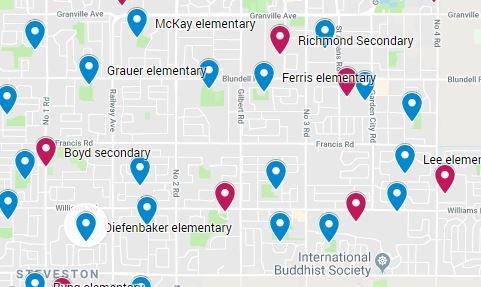The Richmond School District is assessing its various facilities and is looking for feedback on its draft Long-Range Facilities Plan. This Richmond News article is the first in a five-part series, enhanced with online graphics, to look at the issues, including enrolment, growth and the condition of school district buildings, the Richmond Board of Education is facing.
There are more than 5,000 empty seats in Richmond schools and the school district is trying to figure out how best to manage this excess space.
The number of empty seats are not evenly distributed. Certain areas, such as west Richmond, have many elementary schools that are operating below capacity, while in the city centre schools are full and expected to be over capacity by 2033 unless other schools are built or existing ones expanded.
For example, Blair, Whiteside and Spul’u’kwuks elementary schools are more than full, while Palmer secondary is only at 50 per cent capacity and Sea Island elementary, with a total of 24 students, is at 13 per cent capacity.
In defining “capacity utilization,” the draft Long-Range Facilities Plan (LRFP), recently released for public feedback, states that a “reasonable” target would be 85 to 90 per cent. This would enable the school district to offer a “consistent and equitable range of programs” to all schools and support any capital funding requests.
The ministry funds school districts largely based on a per-student amount, therefore, if a school has very few students or small classes, it is more expensive to deliver programs.
The total number of seats in Richmond schools, or its “operating capacity,” is 24,751, but there are only 19,366 students currently enrolled (not counting international students), which means there are 5,385 surplus seats in classrooms.
But even with growth expected over the next 15 years, there is still expected to be 2,256 surplus seats in 2033 if no changes, except those currently underway, are made to school buildings.
To best use space in the school district, the draft LRFP sets out strategies, for example, catchment boundary changes, moving choice programs and using school space for health and social services. If it did that, the district could ask the ministry to exempt this space when calculating school utilization. Another strategy is consolidating school populations, which could lead to school closures.
The LRFP explains that the Ministry of Education expects the utilization of schools to be “as high as possible” to justify capital projects.
In calculating how much capacity there is in schools, classrooms leased out to child care providers are counted as empty space.
However, the school board has asked the education ministry to remove these child care facilities from their capacity calculations if they are permanent child care programs.
To see the draft LRFP and provide feedback, go to LetsTalkSD38.ca. The first open house will be held on Thursday, April 4, 6-8 p.m. at MacNeill secondary, 6611 No. 4 Rd.



